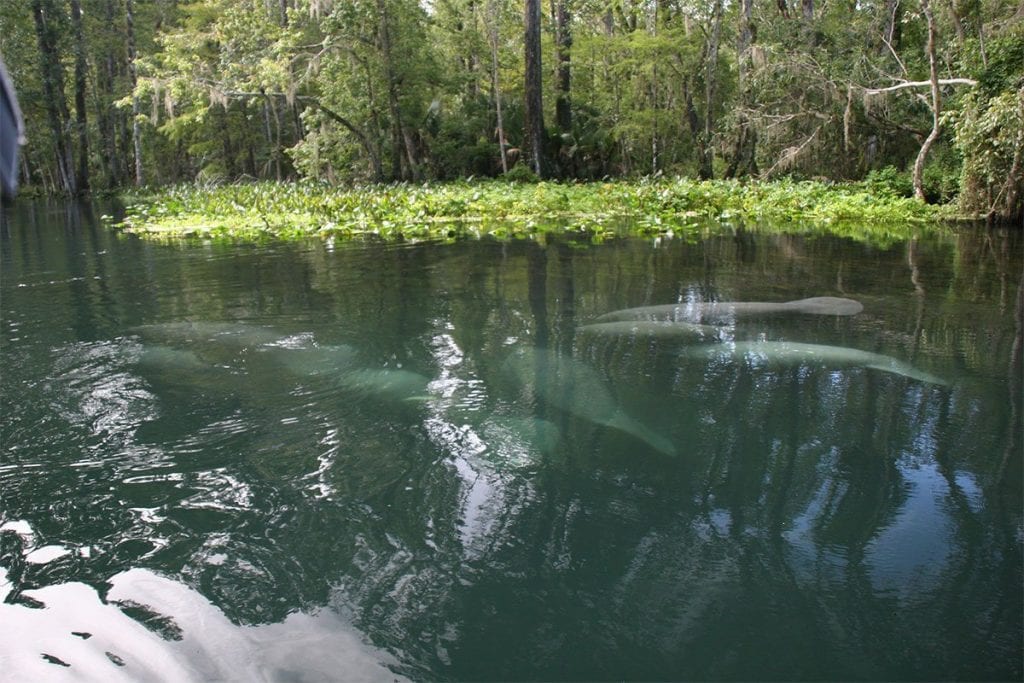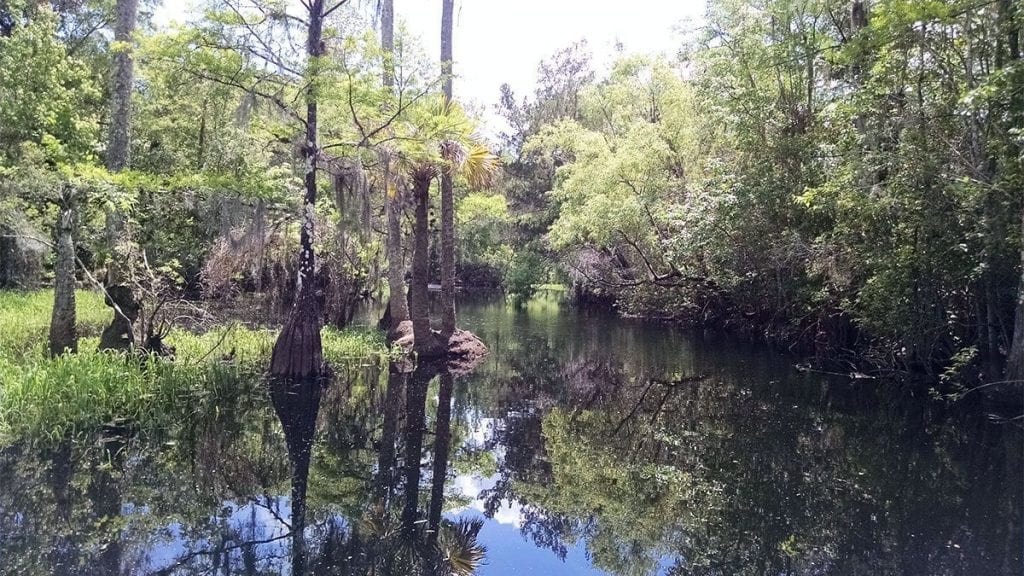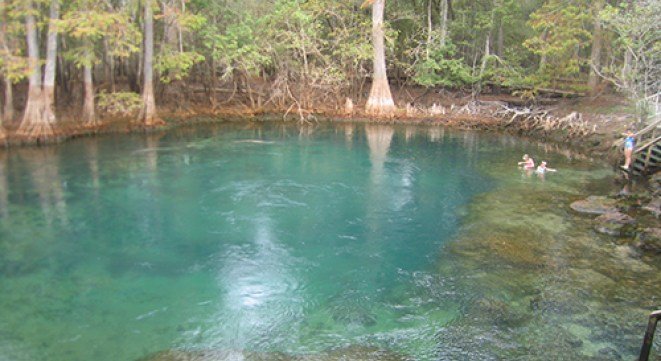CMA recognizes the unique and invaluable nature of Florida’s natural springs. These extraordinary habitats are of importance to Floridians, who enjoy swimming, diving, and boating in such a unique environment; and are of special importance to many aquatic species in Florida.
Resource managers must maintain a balance between preserving this natural resource and allowing different degrees of recreational use. Growing coastal populations in Florida put increasing pressure on freshwater resources, resulting in reduced spring flow and declining water quality. CMA recognizes the potential for conflict at this interface between growing coastal populations and habitats and natural resources under pressure to sustain high levels of use.
Monitoring Manatee Use of Florida Springs

Monitoring Manatee Use of Springs within the St. Johns River During Winter
Florida contains a myriad of natural springs that could provide warm water for manatees to use during the colder months to help them survive through winter. Unfortunately, along the east coast of Florida, only one spring located in the St. Johns River currently has protection rules in place to provide a safe refuge for the species in winter. The population at this spring continues to increase, along with the overall manatee population, while the availability of other warm water sites decreases. The St. Johns River contains many springs that remain unstudied and unprotected; these will play an increasingly vital role for future manatee survival as the population continues to grow and other historic habitats become less viable.
A decade ago, our researchers began monitoring several springs along the St. Johns River to record manatee abundance and distribution, human usage, and environmental data to understand manatee population use throughout winter and from year-to-year. We have baseline data collected on five Central Florida springs: Salt and Silver Glen Springs in Ocala National Forest, Marion County, Deleon Spring in Volusia County, and Welaka and Mud Springs in Putnam County. Data indicated that three of five springs would sustain manatees throughout a winter and have full seasonal manatee usage. Currently, none of these springs contain locally or federally protected manatee sanctuaries, but our data has led to conservation interventions within several of these habitats.
Our researchers continue monitoring efforts at Salt, and Silver Glen, and Welaka springs, those areas deemed as sustainable manatee habitats. Within these springs, our team conducts monthly boat-based field observations to document manatee behavior, temperature and salinity, recreational use within the spring, habitat parameters, and photo-documentation of individual manatees for identification.

Monitoring the Silver River for Manatee Use
Our team is currently working to determine the viability of the Silver River as a wintering habitat for manatees through monitoring and environmental data collection. Our initial data illustrates that manatees are indeed utilizing this extremely viable system, yet most individuals are not remaining within the region for any reasonable amount of time. Coupling this data with the extensive amount of recreational use within the river, our determination is that there is a high a level of manatee-human interaction occurring in the region which needs educational attention.
Monthly surveys are currently being conducted to assess manatee use throughout the year in the Silver River system and to determine if the habitat use differs based on seasonality. We are also working to increase public outreach education efforts on the best practices for recreational manatee observation that will lead to a decline in human disturbance to manatees.

Tracking Manatee Use of the Ocklawaha
The results from our tracking studies are shared with federal and state authorities in an effort to address management and regulation interest, particularly for many of the unprotected springs throughout Florida. One such region is the Ocklawaha River located in central Florida which contains diverse habitats and spring systems.
At the request of the Florida Fish & Wildlife Conservation Commission, our team recently began monitoring this region to determine how manatees are moving throughout the system. Our researchers were able to initiate a manatee tagging program, where we tracked and monitored two manatees to record their use of the river and springs, collecting the first-ever data of manatee habitat and distribution use of the Ocklawaha system. Our tracking program is continuing in this region with at least two additional manatees scheduled for tagging this season to better understand manatee use of this amazing system.
The team anticipates this region becoming a long-term monitoring and tracking target for our organization as we continue to collect information to provide to government agencies for future protection and restoration decisions.
Monitoring Florida Springs Habitat

Ulele Springs Restoration Monitoring
Ulele Spring is a natural freshwater spring along the Hillsborough River near downtown Tampa, Florida. Approximately 100 years ago the spring run was filled in and replaced with a pipe system which prohibited fish, manatees, and other flora and fauna from entering the spring basin. Restoration efforts completed in 2014 removed the pipe system and allowed the streambed to flow naturally, restoring estuarine and freshwater habitat between Ulele Spring and the Hillsborough River. Once the streambed was restored and the connection between freshwater and estuarine systems re-established, species typical of Tampa Bay and the lower Hillsborough River were expected to colonize the spring system, including freshwater and brackish aquatic plants, recreationally-popular fish, and the endangered Florida manatee. We received funding to monitor the recolonization of Ulele Spring, collecting baseline data on how quickly a restored spring can return to a natural system and provide habitat to local aquatic species.
Silver Glen and Salt Springs Study
Physical use of springs can cause damage that might not be apparent during infrequent observations but becomes clear when documented over a season or on an annual basis. Salt Spring and Silver Glen Spring, located along the St. Johns River, face threats from human recreational use rather than declining water quality or reduction in spring flow, which are the main threats facing many of Florida’s springs. Recreational boating within both Silver Glen and Salt Springs has been substantial and often navigational waterway access has been blocked by the sheer volume of moored boats. Boating and foot traffic to access the swimming areas of the springs has been noted as eroding stream banks, scarring and/or trampling native aquatic vegetation, as well as encouraging the spread of invasive species throughout the spring run.
We initiated a five-year study to obtain baseline environmental and vegetation abundance data at Silver Glen and Salt Springs. We also documented if boat restriction zones resulted in changes in vegetation abundance and growth throughout the winter season. The results of this project were provided to state and federal managers to assist in establishing appropriate and adequate protection measures for valuable spring habitat, and to help educate recreational users on how to preserve the habitat while also enjoying it.
Silver Glen and Salt Springs continue to be monitored by the CMA Research Institute team.

Protect Florida Springs License Plate
CMA staff were instrumental in the creation of the “Protect Florida Springs” license plate in 2007. Proceeds from plate sales have since funded over $400,000 in competitive grants for springs research, outreach and education throughout the state of Florida.
In 2007 the Florida legislature enacted a bill which in part created the “Protect Florida Springs” license plate. Florida’s Springs are severely threatened due to pollution resulting in decreased water quality, development of shorelines, erosion caused by increasing human use, and in particular, reduced water flow as a consequence of water extraction for municipalities, agriculture, and drinking water.
Funds collected support a Springs Grants Program, which aids on-going community-based initiatives aimed at springs restoration, research, protection, education and outreach around the state. The goal of these efforts is to enhance conservation, protection and management of these valuable resources for the enjoyment of all Floridians and Florida species now and in the future.
CMA chairs the Springs Grants committee, with valuable participation from private Florida citizens, the Florida Fish and Wildlife Conservation Commission, Department of Environmental Protection, Department of Health, Department of Economic Opportunity, and the Wildlife Foundation of Florida. CMA staff are also becoming involved in springs education and outreach initiatives throughout the state of Florida.
Two easy ways you can help protect and preserve Florida’s unique springs:
- Buy a “Protect Florida Springs” license plate today
- Renew your existing “Springs” plate
Order online or visit any Florida Tax Collector’s office.
Making Waves
- 1600+ rescued sea turtles since 2010
- 2100+ Nests monitored since 2010
- 850+ Animals released since 2010
- 190K Volunteer Hours 2020-2021